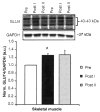Regional muscle glucose uptake remains elevated one week after cessation of resistance training independent of altered insulin sensitivity response in older adults with type 2 diabetes
- PMID: 22522495
- PMCID: PMC4457376
- DOI: 10.3275/8333
Regional muscle glucose uptake remains elevated one week after cessation of resistance training independent of altered insulin sensitivity response in older adults with type 2 diabetes
Abstract
Background: Aging is associated with a decline in skeletal muscle size.Muscle is critical both for mobility and glucose disposal. While resistance exercise (RE) increases muscle mass and function in the elderly, its role in improving glucose utilization is less clear.
Aims: To investigate whether muscle size was linked with insulin sensitivity (IS) in elders with diabetes following RE and if regional muscle glucose uptake differed from systemic glucose utilization.
Methods: Seven (68.4 ± 5.9 yr) adults with diabetes participated. After 16 weeks of RE, within 24 h (post 1) and after 1 week of no exercise (post 2), lean tissue cross-sectional area (CSA) and IS via glucose infusion rate (GIR) were assessed along with a standardized 18-F fluorodeoxyglucose (FDG)-positron emission tomography uptake value (SUV).
Results: CSA increased between pre-test (108.5 ± 35.3 cm2) and post 1 (116.8 ± 40.9 cm2), p=0.02 and did not differ at post 2 (116.0 ± 39.3 cm2). GIR during the 40 mU/m2/min insulin clamp differed between pretest (22.0 ± 15.8 mg/kg/min) and post 1 (67.9 ± 72.8 mg/kg/min), and post 1 and post 2 (25.0 ± 27.2 mg/kg/min) but not between pre-test and post 2. GIR results during the 200 mU/m2/min insulin clamps also differed between pre-test and post 1, and post 1 and post 2 but not between pre-test and post 2. FDG-SUV increased between pre-test (1.1 ± 0.2) and post 1 (1.4 ± 0.3), and remained stable between post 1 and post 2 (1.4 ± 0.4).
Conclusion: RE that increased muscle size and FDG-SUV improved IS 24 h but not 1 week after exercise training.
Figures



References
-
- Canadian Diabetes Association Clinical Practice Guidelines Expert Committee. Physical activity and diabetes. Can J Diabetes. 2003;27 (Suppl 2):S24–6.
-
- American Diabetes Association. Standards of medical care in diabetes--2008. Diabetes Care. 2008;31(Suppl 1):S12–54. - PubMed
-
- Sigal RJ, Kenny GP, Wasserman DH, Castaneda-Sceppa C, White RD. Physical activity/exercise and type 2 diabetes: a consensus statement from the American Diabetes Association. Diabetes Care. 2006;29:1433–8. - PubMed
-
- Karakelides H, Nair KS. Sarcopenia of aging and its metabolic impact. Curr Top Dev Biol. 2005;68:123–48. - PubMed
Publication types
MeSH terms
Substances
Grants and funding
LinkOut - more resources
Full Text Sources
Medical
Research Materials

